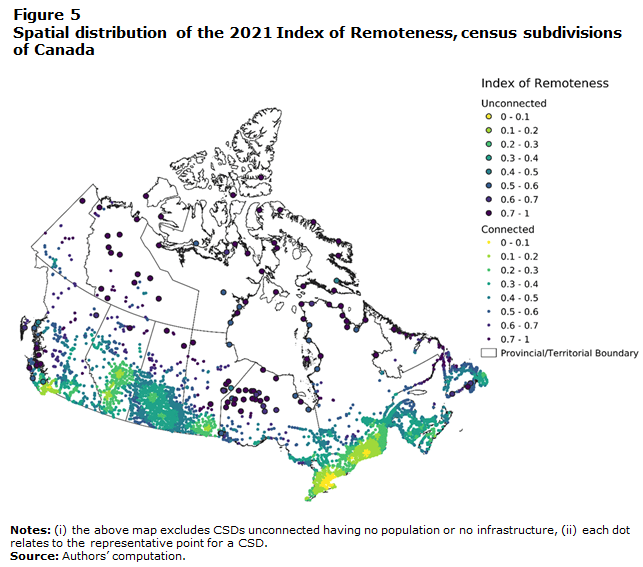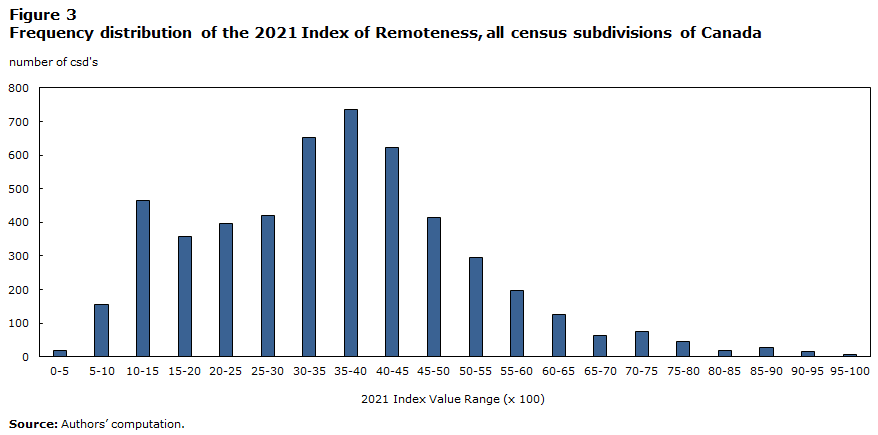Where can I move in Canada and still be connected to a big city?
At the start of 2023, Statistics Canada revealed its updated Index of Remoteness (IOR), a study that looked to establish a “remoteness” score to every habitable place in Canada.
Learn more about Canadian immigration and discover your options
The study assessed different kinds of "Census Subdivisions (CSD)” i.e.: Cities, Municipalities, Villages, Townships, etc.—across Canada—to determine the distance and ease of travel between each CSD and a major population center (defined as an area with a population of at least 1,000 and no fewer than 400 persons per square kilometer).
The study further assigns a score between 0 (closest to a population center) and 1 (the most remote score possible) to each CSD. This is with the use of a formula that considers the population of centers that can be reached by a particular CSD (proxy to quality of goods and services), cost of travel, and how many population centers can be reached by that CSD within or equaling a travel cost of $36 CAD (the equivalent of 2.5 hours of travel). This formula score is then indexed to finally end up with a score of remoteness between 0 and 1.
Since the IOR considers physical distance, travel cost, and number of population centers accessible on a daily basis—these remoteness scores can be telling of the ease of access to resources and services that are predictors of socio-economic outcomes (like education, healthcare, economic opportunities, etc.), in different CSDs.
How can you use the Index of Remoteness?
The IOR is an excellent spring-board for candidates and successful applicants to begin their search on a place to settle in Canada. While the scores are not detailed in themselves, they do help readers get a general idea of distance, travel costs, and services available to people in those locations. Once readers have this score, they can then move on to research further specifics like communities, travel distances, and cost of living in the location(s) they are interested in.
This can be particularly pertinent to Provincial Nominee Program (PNP) applicants, whose acceptance to Canada as permanent residents is usually tied to their settling in a specific province or city.
Per the latest immigration data, here are the remoteness scores for the cities that welcome the most newcomers in 2022:
If your location of interest is not listed here, you can directly download the full spreadsheet of data directly from Statistics Canada. Once you have the sheet open, simply search your desired location to find the IOR score between 0 and 1 (note that special characters on names may not format correctly in the spread sheet).
General Insights
Below are the averaged scores of remoteness from the IOR (which factors in 2021 census data), for all provinces and territories. The scores consider CSDs that newcomers are most likely to settle in: cities, communities, municipalities and municipal districts, townships, and villages.
Note that not all provinces had the desired CSDs. Provinces that had some but not all are denoted by “*”.
Provinces that have none of the desired CSDs are denoted with “**”. For these, the total CSDs in the province are totalled and averaged.
As expected, the provinces that welcome the most newcomers (Ontario, Quebec, British Columbia) have the lowest average remoteness scores, while provinces and territories with smaller populations had higher scores.
Notably, all provinces and territories—excluding Ontario, Quebec and British Colombia—were missing some or all of the desired CSDs that newcomers tend to frequent, which should be considered when judging their remoteness scores.
As many may predict based on population reports, remoteness scores generally increase (become more remote) as one travels further north in Canada. The following image from the remoteness study bears this out.

In addition, the image below shows the spread of scores of all CSDs in Canada. Most CSDs fall within the 0.10—0.55 range of IOR scores, indicating that while remoteness was less of a problem for the majority of the population, the sheer size of Canada (which has one of the lowest population densities in the world, at 4 persons per square kilometer of land) has likely skewed scores towards higher remoteness brackets.

Despite the centralization of the population around specific provinces, Immigration Minister Sean Fraser stated in 2022 that Immigration Refugees and Citizenship Canada (IRCC) will continue to push the benefits of immigration to wider parts of Canada, with smaller populations and need for newcomers—a policy that should help drastically bring down overall remoteness scores as well, and is already on the way to being implemented. In the latest immigration levels plan, wherein the PNP has overtaken Express Entry as Canada’s main pathway for immigration.
Learn more about Canadian immigration and discover your options
© CIC News All Rights Reserved. Visit CanadaVisa.com to discover your Canadian immigration options.
- Do you need Canadian immigration assistance? Contact the Contact Cohen Immigration Law firm by completing our form
- Send us your feedback or your non-legal assistance questions by emailing us at media@canadavisa.com







